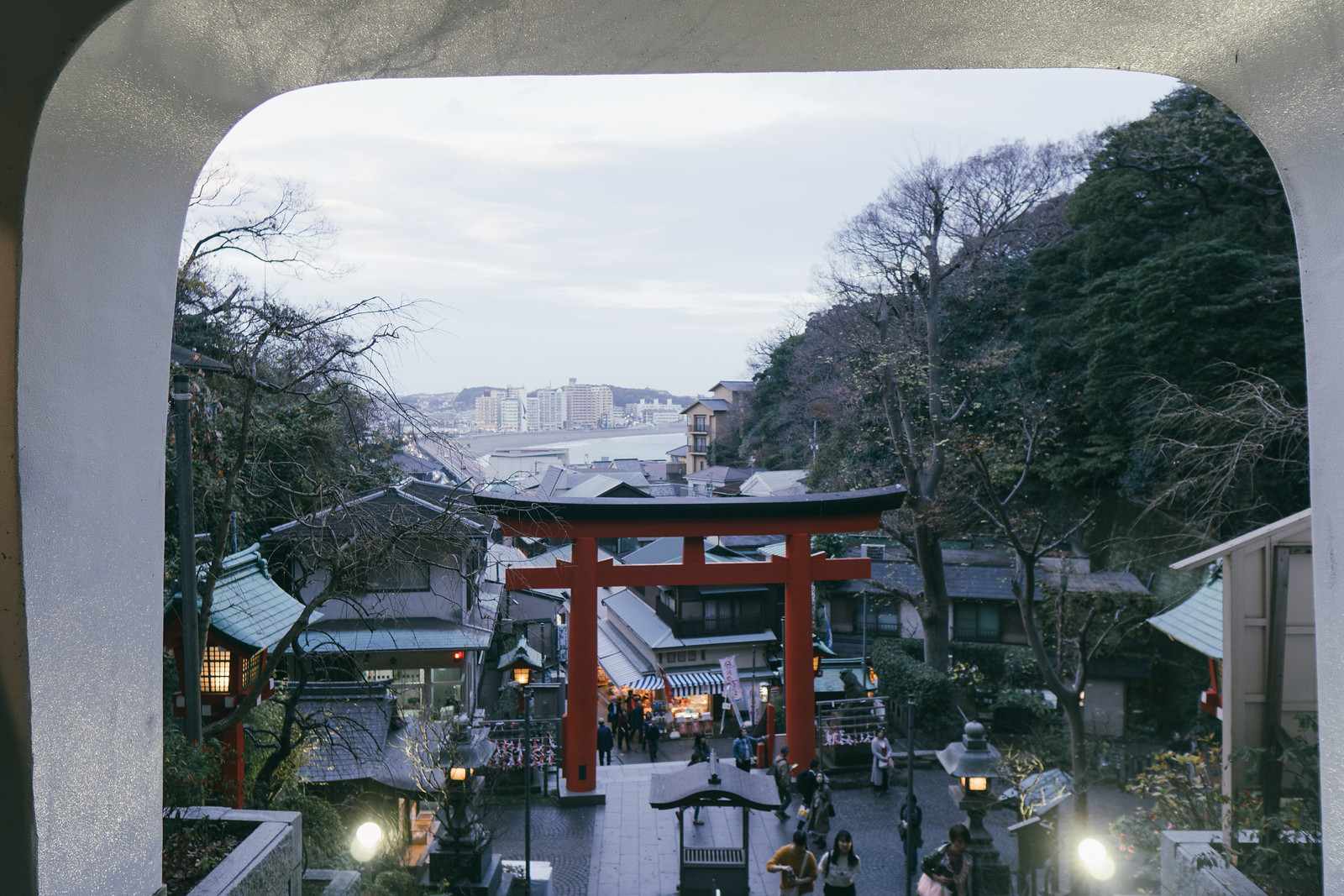2 Days in Enoshima & Kamakura, Japan
On our second visit to Tokyo, we added a two-day getaway to the coastal area in Kanagawa prefecture (神奈川). We stayed in Fujisawa, and spent a day in Enoshima and the other in Kamakura. It felt more relaxing and calm compared to the hustle and bustle of Tokyo, and I enjoyed two delicious meals of silver fish (しらす shirasu, 吻仔魚) in Enoshima.
Lodging
We stayed 2 nights in Fujisawa, a bigger city with easy access to Enoshima, Kamakura, and Tokyo. There were also plenty of restaurants and shops, plus an arcade near the train station. We picked the chain hotel Sotetsu Fresa Inn, the room was a bit small but the location was convenient.
Transportation
For both days in Enoshima and Kamakura, we took the classic green Enoden. If taking more than 2 rides, it is worth buying the Enoden 1-day pass ticket “Noriorikun.” We got the 1-day pass on the day we visited Kamakura, as we stopped by different stops along the coast.


Enoshima highlights
Enoshima Shrine (江島神社)
The Enoshima Shrine sits on the first flight of stairs from the bottom of Enoshima Island. This shrine is one of the Three Great Shrines of Benzaiten, and people come here to worship and pray. It felt serene to walk around the shrine, with a scenic view of the island and ocean.


Samuel Cocking Garden & Enoshima Sea Candle
After climbing some stairs, we arrived at Samuel Cocking Garden and Sea Candle. In the winter (usually late November to mid-February), the illuminations are certainly a highlight on the island. The whole garden was lit up with various shapes of lights, and it was like walking in a dream. We also rode the elevator to the top of the Sea Candle, with a 360 view from the top of the island. The Sea Candle serves as a lighthouse, flashing its signals to the boats far away.


Taking a walk on Enoshima Island
Before dinner at Tobiccho, we walked around the island for a while. At the Shotenjima Park (聖天島公園), we encountered quite a few cats meditating. Originally, we also planned to check out the Iwaya Cave by the sea. However, the hours didn’t work out with our schedule as they close earlier in the winter (4 pm at the time of writing).


Shirasudon at Tobiccho
My cousin recommended this shirasudon restaurant to me, and it was very popular the first time we walked by. Shirasu fishing is forbidden from January to March, and April and May are anecdotally the best seasons for fresh shirasu (after 3 months of freedom). We went before dinner rush hours, and were seated upstairs along with other Japanese speaking families. We got two shirasu donburis, one fried with other seafood and the other one more raw. I grew up loving shirasu as toppings in rice bowls and soup in Taiwan, and this is one of the reasons I came to Enoshima for.


Kamakura highlights
From 1185 to 1333, also called the Kamakura period, the first shogunate (military government holding the most power) was formed and the leaders (shoguns) were based in Kamakura.
After getting off the Kamakura station, we walked through the 小町通, had lunch at a curry house, and then to the intersection before the Tsurugaoka Hachimangu.
Tsurugaoka Hachimangu (鶴岡八幡宮)
This is the most famous and important Shinto shrine in Kamakura, with a long history dating back to the Kamakura period. The shrine protected the samurais during the Kamakura period and many historical and cultural events have taken place here. The shrine still hosts events based on their calendar. We walked around the shrine with beautiful paths surrounded by colorful trees, encountered a squirrel, and passed by school children taking a lunch break.


Great Buddha
Based on the temple records, the Great Buddha was established during the Kamakura period around 1252. The bronze statue is 13.35 m (43.8 ft) tall and weighs about 103 tons, the second-largest bronze Buddha statue in Japan. The status used to be held inside a wooden temple, and stands still while the exterior of the temple was destroyed during a tsunami. Despite a tourist spot nowadays, this Buddhist temple still feels serene with trees and people taking selfies. With 20 yen, visitors can enter the inside of the statue.


Oceanview at Inamuragasaki Park (稲村ケ崎海浜公園)
Kamakura is known for surfing for all seasons, along the Shichirigahama Beach (七里ヶ浜). From this seaside park and the walking paths parallel to the beach, I could stay here all day watching the waves and the Island of Enoshima. On certain days, Mt. Fuji appears to the right of Enoshima (higher chance in the winter with lower humidity), though we didn’t get to see this that day.


Kamakurakokomae Station (In front of the Kamakura school 鎌倉高校前)
Other than a scenic train station with ocean view, this Enoden train station is known for the scenes from the popular basketball manga/anime Slam Dunk. The main characters met at the railroad in the opening song, and we spotted many people taking photos with the exact background right after we got off the station. In the meantime, the school just rang the bell and throngs of students from the Kamakura high school walked to the train station. After getting our tourist photos, we took the train back with all the high school students in uniform.


Curry at Caraway
We stopped by this cozy Japanese curry restaurant on the way to Tsurugaoka Hachimangu. The menu was simple, and the curry was meaty and tasty. The restaurant became packed soon after we arrived around 11 am, and I loved the ambiance of this low key curry house.

Wrapup
The lifestyle in Enoshima and Kamakura was a lot more relaxing than Tokyo, and I could never have enough of ocean view. I would certainly come back here for shirasudon, a beautiful walk in Enoshima and an Enoden ride. Finally, here are our lists of Tokyo/Yokohama/Kamakura, and the 8-day itinerary.
